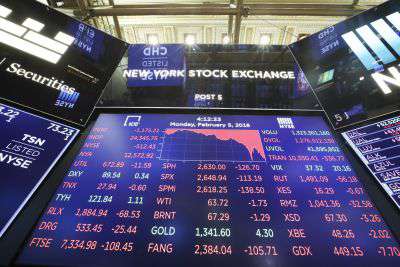New York: Wall Street is wobbling between gains and losses Tuesday in its first trading after tumbling into a bear market on worries about a fragile economy and rising rates.
The S&P 500 was 0.1% higher in early trading after a couple big companies flexed financial strength with stronger profits and payouts to shareholders.
It was an unsteady gain, though, with the index swinging between a 0.1% loss and a 0.8% rise within the first half hour.
The Dow Jones Industrial Average was up 5 points, or less than 0.1%, at 30,522, as of 10:20 am Eastern time, and the Nasdaq composite was 0.1% higher after swinging between a gain of 0.9% and a loss of 0.3%.
Trading across markets was much calmer, if still tentative, following Monday’s worldwide rout.
Treasury yields were easing back from their highest levels in more than a decade.
Stocks across Asia and Europe were also mixed, while a measure of nervousness among stock investors on Wall Street was edging lower.
One notable exception was bitcoin, which fell another 6.5% to drop below $22,100, according to CoinDesk.
Cryptocurrencies have been among the most punished in this year’s sell-off for markets, as the Federal Reserve and other central banks raise interest rates in order to rein in inflation and forcefully turn off the “easy mode” that helped prop up markets for years.
Offering some support to the market was a report that showed inflation at the wholesale level was a touch lower in May than expected, though it remains very high.
Economists said the data won’t keep the Federal Reserve from hiking its key interest rate this week by a larger-than-usual amount, with some even speculating the largest increase since 1994 that’s triple the usual amount.
But the figures offer a bit of salve following last week’s market-bludgeoning report that showed inflation at the consumer level accelerated last month, instead of getting better.
A relatively reliable warning signal of recession in the bond market was also dimming.
The yield on the two-year Treasury fell back below the 10-year yield, at 3.32% versus 3.35%.
The two-year yield is typically lower than the 10-year yield, and in the unusual circumstances where it isn’t, some investors see it as a sign that a recession may be hitting in about a year or two.
On Wall Street, Oracle soared 9.5% after it reported stronger revenue and earnings for its latest quarter than analysts expected.
FedEx jumped 14.2% after it boosted its dividend payout by more than 50%.
It was the first trading for U.S. Stocks after the S&P 500 closed Monday at 21.8% below its record set early this year.
That put it in a bear market, which is what investors call a drop of 20% or more.
At the centre of the sell-off is the U.S. Federal Reserve’s effort to control inflation by raising interest rates.
The Fed is scrambling to get prices under control and its main method is to raise rates, but that is a blunt tool that could slow the economy too much and cause a recession.
Other central banks worldwide, including the Bank of England, have been raising rates as well, while the European Central Bank said it will do so next month and in September.
The war in Ukraine is sending oil and food prices sharply higher, fueling inflation and sapping consumer spending, especially in Europe.
COVID infections in China, meanwhile, have led to some tough, business-slowing restrictions that threaten to restrain the world’s second-largest economy and worsen snarled supply chains.
“The old, pre-corona equilibrium, with low inflation, ultraloose monetary policy and low geopolitical risk premiums no longer holds,” said Andreas Koester, head of portfolio management at Union Investment in Frankfurt, Germany.
“Now we are in a transition to a new, post-corona equilibrium, of which only the outlines are visible, such as higher inflation levels or a return to great power competition on the international scene,” Koester added.
The shift by central banks, especially the Fed, toward higher interest rates has reversed the spectacular rise in stock prices spurred by massive support for markets after the pandemic hit in early 2020.
Markets are bracing for more bigger-than-usual hikes, on top of some discouraging signals about the economy and corporate profits, including a record-low preliminary reading on consumer sentiment soured by high gasoline prices.
Higher interest rate benchmarks raise returns on less speculative investments such as bonds, increasing their attractiveness relative to stocks.
And the moves by design will slow the economy by making it more expensive to borrow.
The risk is central banks could cause a recession if they raise rates too high or too quickly.
Last month, the Fed signalled additional rate increases of double the usual amount are likely in coming months. Consumer prices in the U.S. Are at the highest level in four decades, and rose 8.6% in May compared with a year ago.
AP






































